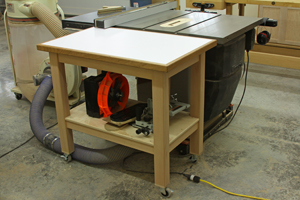
I bought an old (1983) Black & Decker 8″ table saw model 9419. The size of the table saw is about 36″ in length if I’m correct (since I have not measured yet). This table saw seems small, but I would like professional opinions on how I could make the best of it for any type of job. The other concern I have is the blade size: the biggest size it can use is 8″. That size is hard to get since no one makes them any longer. I’m using 7-1/4″ blades for circular saws. Would the blade thickness make a difference on the table saw? What can I do to extend the cutting area? I’m thinking of building an extension for the sides and back, but I have very limited space in my garage since I park two cars inside. Any help would be appreciated. Thank you. – Jose Lamar
Chris Marshall: Good for you, trying to keep an old table saw alive! About the best you can do to expand “cutting area” — which mostly means supporting longer or wider workpieces during a cut — is to add more table area alongside and in back of your saw, as you are planning to do. I once used a hinged outfeed table bolted to my cabinet saw, which worked really well for adding support without wasting space. But on a saw as small as yours, where the weight of a hinged table could possibly tip it over, I’d suggest making a separate table that matches the height of your saw and moving it in place when you need it, then using it for other shop purposes (a glue-up or finishing table, a spare work surface for staging parts, etc.) when you don’t. That’s actually what I’m doing right now behind my current saw, and it works great. Regarding blades, you’re on about the only track you can follow: buy “thin-kerf” blades that don’t exceed the maximum diameter intended for the saw. A thin blade will help you maximize the power of a smaller saw so you can cut a variety of materials without bogging down the motor. Blades made for circular saws may be your only choice, but they should work just fine. (Note: Freud still makes various styles of its Diablo blades in 8- to 8-1/4-in. diameters — click here for a link.)
Tim Inman: You don’t say what type work you’re wanting to do, so I’ll just “dream” a little for you. In my shop, I do mostly antique furniture restoration and conservation. So that’s my focus. I often make up small amounts of veneer inlay and stringing for special jobs. I’d turn your little saw into a veneer trimmer/cutter. A small super-fine thin blade would be my choice. A little saw like you’re describing could be hung on countertop hinges so it could be dropped out of the way when you’re not using it, and tipped up into working position when duty calls. There are tons of specialty cutting operations to which you could dedicate this saw. Smaller blades should not be a problem as long as they will rise high enough to do your cutting requirements. My biggest concern though is your last statement. If you are really tight on space, you might find that re-selling that little saw is your best option. A specialty setup will eat space that might not otherwise be justified. Tools have to earn their keep just like everybody else!





